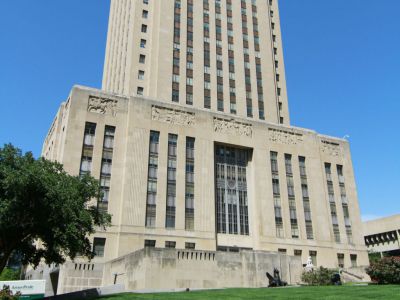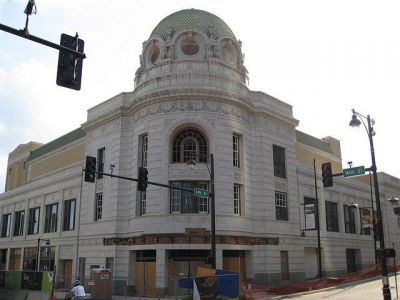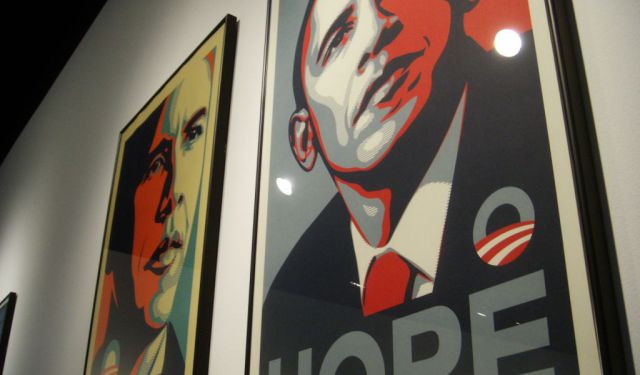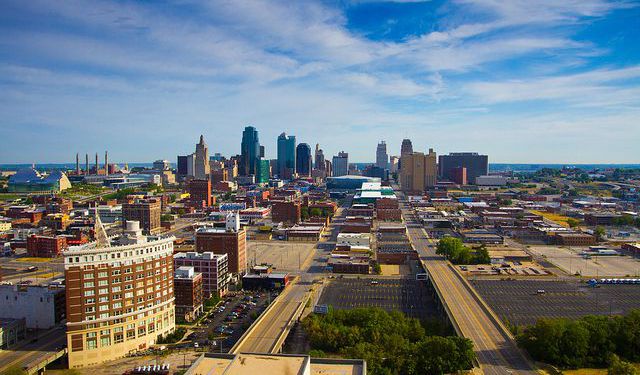Historical Buildings Tour (Self Guided), Kansas City
The historical buildings of Kansas City are truly remarkable, weaving a narrative of rich heritage and enduring elegance reflecting the city's eventful past and lasting beauty.
At its heart, the imposing Kansas City City Hall rises as a prime example of Neo-Classical and Beaux-Arts architecture, a stalwart symbol of civic pride that has stood the test of time.
As you stroll through the city, you can't miss the Mainstreet Theater, showcasing the elegant blend of Neo-Classical and French Second Empire styles once popular in the 1920s.
The Power & Light Building, on the other hand, is a great representation of Art Moderne architecture, reaching for the sky with its innovative design.
Behold the Midland Theatre, a historic gem where you can still hear the echoes of applause from generations past reverberating within its walls.
Meanwhile, the Kansas City Public Library stands not just as a repository of knowledge, but as a monument to the intellectual pursuits that have shaped the city's evolution.
The New York Life Building adds a touch of Renaissance Revival elegance to the skyline, while the Commerce Trust Building's Gothic Revival architecture reflects the city's ideals of trust and stability.
In totality, these buildings narrate the story of Kansas City's progress, each edifice being a chapter in its story of tenacity, progress, and unwavering power of human endeavor. So, next time you're in Kansas City, take a moment to appreciate these architectural wonders. They remind us of the city's journey and the people who made it possible.
At its heart, the imposing Kansas City City Hall rises as a prime example of Neo-Classical and Beaux-Arts architecture, a stalwart symbol of civic pride that has stood the test of time.
As you stroll through the city, you can't miss the Mainstreet Theater, showcasing the elegant blend of Neo-Classical and French Second Empire styles once popular in the 1920s.
The Power & Light Building, on the other hand, is a great representation of Art Moderne architecture, reaching for the sky with its innovative design.
Behold the Midland Theatre, a historic gem where you can still hear the echoes of applause from generations past reverberating within its walls.
Meanwhile, the Kansas City Public Library stands not just as a repository of knowledge, but as a monument to the intellectual pursuits that have shaped the city's evolution.
The New York Life Building adds a touch of Renaissance Revival elegance to the skyline, while the Commerce Trust Building's Gothic Revival architecture reflects the city's ideals of trust and stability.
In totality, these buildings narrate the story of Kansas City's progress, each edifice being a chapter in its story of tenacity, progress, and unwavering power of human endeavor. So, next time you're in Kansas City, take a moment to appreciate these architectural wonders. They remind us of the city's journey and the people who made it possible.
How it works: Download the app "GPSmyCity: Walks in 1K+ Cities" from Apple App Store or Google Play Store to your mobile phone or tablet. The app turns your mobile device into a personal tour guide and its built-in GPS navigation functions guide you from one tour stop to next. The app works offline, so no data plan is needed when traveling abroad.
Historical Buildings Tour Map
Guide Name: Historical Buildings Tour
Guide Location: USA » Kansas City (See other walking tours in Kansas City)
Guide Type: Self-guided Walking Tour (Sightseeing)
# of Attractions: 7
Tour Duration: 1 Hour(s)
Travel Distance: 2.0 Km or 1.2 Miles
Author: tina
Sight(s) Featured in This Guide:
Guide Location: USA » Kansas City (See other walking tours in Kansas City)
Guide Type: Self-guided Walking Tour (Sightseeing)
# of Attractions: 7
Tour Duration: 1 Hour(s)
Travel Distance: 2.0 Km or 1.2 Miles
Author: tina
Sight(s) Featured in This Guide:
- Kansas City City Hall
- Mainstreet Theater
- Power & Light Building
- Midland Theatre
- Kansas City Public Library
- New York Life Building
- Commerce Trust Building
1) Kansas City City Hall
The 29-story city hall building sits between East 11th and 12th Streets and Oak and Locusts Streets. It was built in 1937 in the Neo-Classical and Beaux-Arts styles. It's one of the tallest city halls in the country and is known for its Art Deco details–especially on the interior.
There are elaborate marble stairways and lots of bronze features that honor Kansas City's history. Details range from simple things like the doorknob plates to elaborate sculpted brass elevator doors. Statues and fountains surround the building at ground level. The six-story base structure's top floor is capped with relief sculptures depicting the city's early years and growth.
For visitors, the building is also notable for its 30th-floor observation deck. The building is the third tallest in the city, but it dominates the skyline since it stands on a hill. The views of the city and the surrounding historic buildings can't be beaten.
There are elaborate marble stairways and lots of bronze features that honor Kansas City's history. Details range from simple things like the doorknob plates to elaborate sculpted brass elevator doors. Statues and fountains surround the building at ground level. The six-story base structure's top floor is capped with relief sculptures depicting the city's early years and growth.
For visitors, the building is also notable for its 30th-floor observation deck. The building is the third tallest in the city, but it dominates the skyline since it stands on a hill. The views of the city and the surrounding historic buildings can't be beaten.
2) Mainstreet Theater
Sometimes called the Empire Theater, the Mainstreet was built in 1921 and designed by Chicago firm Rapp & Rapp. Vaudeville and movies were popular shows at the 3,200 seat theater for many years; it was the largest theater in town until the Midland Theater opened in 1927. It's designed in Neo-Classical and French Second Empire styles with a French Baroque interior. There was a tunnel connecting it to the nearby Presidential Hotel to allow actors to enter the theater from their dressing rooms, but it eventually became more useful to bootleggers trying to dodge the police during Prohibition. The basement and sub-basements also had spaces to keep animals for vaudeville shows, including a pool for seals and an elevator large enough for elephants.
Durwood Theaters purchased the theater, the forebearer of AMC, in the late 1950s and renamed the Empire. While it became primarily a movie house, the screen was designed to fold down to allow for the occasional live show. The theater was eventually split into two screens, using the balcony area to add the second theater. By the 1980s, it was operating as a four-screen cinema. The building entered a period of decline with an uncertain future, but a group of concerned citizens rallied behind the building to get it added to the National Register of Historic Places.
The city purchased the building in 2004 as part of its Power & Light District revitalization plan. The theater reopened with its original name under AMC's brand again in 2009. AMC sold off the cinema, and it is now known as the Alamo Drafthouse Cinema Mainstreet. The theater is state-of-the-art, with both 35mm film and 4K 3D digital projectors. The lobby bar is The Chesterfield-Mainstreet, and The Chesterfield is attached with seated dining and a craft cocktail menu.
Durwood Theaters purchased the theater, the forebearer of AMC, in the late 1950s and renamed the Empire. While it became primarily a movie house, the screen was designed to fold down to allow for the occasional live show. The theater was eventually split into two screens, using the balcony area to add the second theater. By the 1980s, it was operating as a four-screen cinema. The building entered a period of decline with an uncertain future, but a group of concerned citizens rallied behind the building to get it added to the National Register of Historic Places.
The city purchased the building in 2004 as part of its Power & Light District revitalization plan. The theater reopened with its original name under AMC's brand again in 2009. AMC sold off the cinema, and it is now known as the Alamo Drafthouse Cinema Mainstreet. The theater is state-of-the-art, with both 35mm film and 4K 3D digital projectors. The lobby bar is The Chesterfield-Mainstreet, and The Chesterfield is attached with seated dining and a craft cocktail menu.
3) Power & Light Building
The Kansas City Power and Light Building stands as a distinguished Art Deco skyscraper in Downtown Kansas City. Constructed in 1931 under the leadership of Kansas City Power and Light President and Edison Pioneer Joseph F. Porter, the building was initially envisioned as a beacon of economic hope, aiming to generate new jobs in the heart of the city. Designed by the local architectural firm Hoit, Price, and Barnes, the Power and Light Building swiftly became a prominent feature of the city's skyline.
Upon its completion, the 34-story tower was the tallest building west of the Mississippi River, maintaining this status until the Seattle Space Needle was completed in 1962. The structure remained Missouri's tallest habitable building until One U.S. Bank Plaza in Saint Louis took the title in 1976. The building's east façade overlooks the Power & Light District, a vibrant area that owes its name to the skyscraper, and its iconic lantern is a symbol of Kansas City, prominently featured on promotional materials and signage for both the district and the city.
After Kansas City Power & Light Company left in 1991, the building remained mostly empty until 2014, when NorthPoint Development transformed it into a residential tower with 210 apartments, 81 more units around a new parking garage, and a lobby repurposed as a premier event space for 500 guests, making it Missouri's tallest residential-only building.
Crowning the Power and Light Building is a stunning Art Deco lantern, adorned with prismatic glass panels that conceal red-orange lights, glowing every evening at sunset. Originally, the building's setbacks were illuminated by multicolor flickering floodlights, creating the impression of blazing flames-a spectacle that has since been modernized with rotating LED floodlights that continue to enchant onlookers with a vivid display of colors.
Upon its completion, the 34-story tower was the tallest building west of the Mississippi River, maintaining this status until the Seattle Space Needle was completed in 1962. The structure remained Missouri's tallest habitable building until One U.S. Bank Plaza in Saint Louis took the title in 1976. The building's east façade overlooks the Power & Light District, a vibrant area that owes its name to the skyscraper, and its iconic lantern is a symbol of Kansas City, prominently featured on promotional materials and signage for both the district and the city.
After Kansas City Power & Light Company left in 1991, the building remained mostly empty until 2014, when NorthPoint Development transformed it into a residential tower with 210 apartments, 81 more units around a new parking garage, and a lobby repurposed as a premier event space for 500 guests, making it Missouri's tallest residential-only building.
Crowning the Power and Light Building is a stunning Art Deco lantern, adorned with prismatic glass panels that conceal red-orange lights, glowing every evening at sunset. Originally, the building's setbacks were illuminated by multicolor flickering floodlights, creating the impression of blazing flames-a spectacle that has since been modernized with rotating LED floodlights that continue to enchant onlookers with a vivid display of colors.
4) Midland Theatre
The Midland Theatre, a historic gem in the Power & Light District of Kansas City, has a rich and varied past. Built in 1927 by Marcus Loew and designed by architect Thomas W. Lamb alongside the Boller Brothers of Kansas City, the theatre was initially named Loew's Midland Theatre. This 3,000-seat venue is notable for being the largest historic theater within 250 miles of the city, showcasing Lamb's late 1920s style with its French and Italian Baroque influences. The building’s exterior, crafted in Renaissance Revival style with cream-glazed terra cotta brick, features intricate details like winged figures, floral designs, and a grand four-story arched window above a copper and gold marquee lit by 3,600 bulbs.
Inside, the theatre is an opulent display of over 500,000 feet of gold leaf, five magnificent Czechoslovakian hand-cut crystal chandeliers, exquisite wood and plaster work, and a collection of irreplaceable art objects and antiques. Originally, the Midland boasted a Robert Morton theatre pipe organ, which was a central feature until the mid-20th century when the rise of larger screen sound movies led to the decline of stage shows and organ music. After a series of relocations, the organ eventually found a new home in the Kansas City Music Hall.
Throughout its history, the Midland has been known by several names, including Saxon Theatre, Midland Stadium, and Midland 1-2-3 Theatre. It briefly operated as an arena in the 1960s, even housing Kansas City's professional bowling team, the Kansas City Stars, before their departure in December 1961.
In 2008, the building went through a significant renovation. The floor plan is now open to allow for standing-room-only events or cabaret-style tables. The office portion of the building now houses lounges and bars. All renovations were done to meet preservation standards, and even the exterior marquee has been restored to look as it did in 1927. The Midland Theatre has been listed on the National Register of Historic Places since 1977.
Inside, the theatre is an opulent display of over 500,000 feet of gold leaf, five magnificent Czechoslovakian hand-cut crystal chandeliers, exquisite wood and plaster work, and a collection of irreplaceable art objects and antiques. Originally, the Midland boasted a Robert Morton theatre pipe organ, which was a central feature until the mid-20th century when the rise of larger screen sound movies led to the decline of stage shows and organ music. After a series of relocations, the organ eventually found a new home in the Kansas City Music Hall.
Throughout its history, the Midland has been known by several names, including Saxon Theatre, Midland Stadium, and Midland 1-2-3 Theatre. It briefly operated as an arena in the 1960s, even housing Kansas City's professional bowling team, the Kansas City Stars, before their departure in December 1961.
In 2008, the building went through a significant renovation. The floor plan is now open to allow for standing-room-only events or cabaret-style tables. The office portion of the building now houses lounges and bars. All renovations were done to meet preservation standards, and even the exterior marquee has been restored to look as it did in 1927. The Midland Theatre has been listed on the National Register of Historic Places since 1977.
5) Kansas City Public Library
The Central Library building was built in 1897. Since 2004 it has been the main branch of the Kansas City Public Library System, and it is where all of the system's administrative activities occur.
The building began life as the First National Bank Building. It's a masterpiece of craftsmanship with marble columns and bronze doors. A major renovation project was necessary to get the building back in shape, and a fifth-floor needed to be added. The library system made it happen thanks to the public-private partnership headed by the Downtown Council.
The Central Library's Missouri Valley room has one of the largest collections of local history in the region, including published materials, newspapers, maps, and other documents from the city's earliest years. There are meeting rooms, screening rooms, and a coffee shop. The building is on the National Register of Historic Places.
The building began life as the First National Bank Building. It's a masterpiece of craftsmanship with marble columns and bronze doors. A major renovation project was necessary to get the building back in shape, and a fifth-floor needed to be added. The library system made it happen thanks to the public-private partnership headed by the Downtown Council.
The Central Library's Missouri Valley room has one of the largest collections of local history in the region, including published materials, newspapers, maps, and other documents from the city's earliest years. There are meeting rooms, screening rooms, and a coffee shop. The building is on the National Register of Historic Places.
6) New York Life Building
The New York Life Building, a 12-story high-rise standing at 54.86 meters (180 feet), is a landmark in the Library District of downtown Kansas City. Completed in 1890, this brick and brownstone tower is recognized as Kansas City's first skyscraper and was notably the first building in the city equipped with elevators. Commissioned by the New York Life Insurance Company, its design was also used for the Omaha National Bank Building in Omaha, completed a year earlier. The New York Life Building is a centerpiece of the Library District and Baltimore Avenue Historic District, surrounded by other historic structures such as the Kansas City Club and the Central Library.
Designed in 1885 by Frederick Elmer Hill of the New York City architectural firm McKim, Mead & White, the building exemplifies the Italian Renaissance Revival style. The New York Life Building's architectural features include an H-shaped footprint, with ten-story wings flanking a twelve-story tower, and a monumental bald eagle sculpture above the main entrance, created by Louis Saint Gaudens and cast in over two tons of bronze.
The building's Italian granite atrium floor and towering presence marked a shift in Kansas City's development, pushing the city's growth southward from its original River Market area along the Missouri River. Before its construction, the tallest buildings in the city were only three or four stories high, making the New York Life Building a transformative addition to the skyline.
In 1970, the New York Life Building was added to the National Register of Historic Places. However, it was abandoned in 1988, and a restoration in 1996 modernized the building with updated energy, communications, and environmental features. In 2010, the Roman Catholic Diocese of Kansas City-Saint Joseph purchased the building, renaming it the Catholic Center. It now serves as the diocese's administrative office, housing approximately 180 employees.
Designed in 1885 by Frederick Elmer Hill of the New York City architectural firm McKim, Mead & White, the building exemplifies the Italian Renaissance Revival style. The New York Life Building's architectural features include an H-shaped footprint, with ten-story wings flanking a twelve-story tower, and a monumental bald eagle sculpture above the main entrance, created by Louis Saint Gaudens and cast in over two tons of bronze.
The building's Italian granite atrium floor and towering presence marked a shift in Kansas City's development, pushing the city's growth southward from its original River Market area along the Missouri River. Before its construction, the tallest buildings in the city were only three or four stories high, making the New York Life Building a transformative addition to the skyline.
In 1970, the New York Life Building was added to the National Register of Historic Places. However, it was abandoned in 1988, and a restoration in 1996 modernized the building with updated energy, communications, and environmental features. In 2010, the Roman Catholic Diocese of Kansas City-Saint Joseph purchased the building, renaming it the Catholic Center. It now serves as the diocese's administrative office, housing approximately 180 employees.
7) Commerce Trust Building
The Commerce Trust Building in Kansas City is a historic 15-story tower completed in 1907 as the home for Commerce Bancshares, the city's largest bank at the time. It stands out as Kansas City's second skyscraper, following the New York Life building, and was the tallest building in Missouri upon its opening. The building is notable for its striking facade, featuring red granite and white terra cotta tiles.
The site previously housed the Kansas City Journal, which was later taken over by Commerce. Interestingly, former U.S. President Harry Truman worked in the building that preceded the Commerce Trust Building. Designed by architect Jarvis Hunt, who also designed Kansas City's Union Station and the headquarters of the Kansas City Star, the building reflects Hunt's prominent role in shaping the city's architectural landscape. The construction was handled by the George A. Fuller Company, renowned for building iconic structures such as the Flatiron Building in New York City and continuing its legacy in skyscraper construction worldwide.
In 1965, Commerce expanded with the addition of Commerce Tower but retained the original Commerce Trust Building for continued use. A significant renovation in 2004 expanded the building’s square footage to 300,000 square feet by filling in the light court between the fourth and 15th floors. This renovation also included a notable feature in the lobby: the illumination of its ornate glass ceiling to mimic natural sunlight, enhancing the building’s historic charm with a modern touch.
The site previously housed the Kansas City Journal, which was later taken over by Commerce. Interestingly, former U.S. President Harry Truman worked in the building that preceded the Commerce Trust Building. Designed by architect Jarvis Hunt, who also designed Kansas City's Union Station and the headquarters of the Kansas City Star, the building reflects Hunt's prominent role in shaping the city's architectural landscape. The construction was handled by the George A. Fuller Company, renowned for building iconic structures such as the Flatiron Building in New York City and continuing its legacy in skyscraper construction worldwide.
In 1965, Commerce expanded with the addition of Commerce Tower but retained the original Commerce Trust Building for continued use. A significant renovation in 2004 expanded the building’s square footage to 300,000 square feet by filling in the light court between the fourth and 15th floors. This renovation also included a notable feature in the lobby: the illumination of its ornate glass ceiling to mimic natural sunlight, enhancing the building’s historic charm with a modern touch.
Walking Tours in Kansas City, Missouri
Create Your Own Walk in Kansas City
Creating your own self-guided walk in Kansas City is easy and fun. Choose the city attractions that you want to see and a walk route map will be created just for you. You can even set your hotel as the start point of the walk.
Crossroads Art District Walking Tour
Situated at the intersection of creativity and culture, the Crossroads Arts District of Kansas City emerges as a thriving hub of artistic expression and cultural vitality. Formerly the industrial and warehouse area, today it is one of the trendiest art communities in the Midwest. As such, this enclave is the place where many progressive art spots have established themselves.
Among its notable... view more
Tour Duration: 1 Hour(s)
Travel Distance: 1.3 Km or 0.8 Miles
Among its notable... view more
Tour Duration: 1 Hour(s)
Travel Distance: 1.3 Km or 0.8 Miles
Kansas City Introduction Walking Tour
Kansas City, Missouri, started in the 1830s as a port city at the confluence of the Missouri and Kansas Rivers. The first European explorers to map the area were the French, who named the river “Cansez,” which eventually morphed into Kansas.
Louis and Clark passed through in 1804, noting that the area was an excellent place to build a fort. The actual settlement didn’t come until later,... view more
Tour Duration: 2 Hour(s)
Travel Distance: 3.7 Km or 2.3 Miles
Louis and Clark passed through in 1804, noting that the area was an excellent place to build a fort. The actual settlement didn’t come until later,... view more
Tour Duration: 2 Hour(s)
Travel Distance: 3.7 Km or 2.3 Miles
The Most Popular Cities
/ view all












